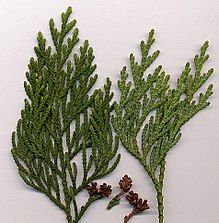Thuja standishii
| Thuja standishii | |
|---|---|

| |
| Thuja standishii foliage and cones upper side left, under side right | |
| Scientific classification | |
| Kingdom: | Plantae |
| Clade: | Tracheophytes |
| Clade: | Gymnospermae |
| Division: | Pinophyta |
| Class: | Pinopsida |
| Order: | Cupressales
|
| Family: | Cupressaceae |
| Genus: | Thuja |
| Species: | T. standishii
|
| Binomial name | |
| Thuja standishii (
Carr. | |
Thuja standishii (Japanese thuja;
Honshū and Shikoku
. It is a medium-sized tree, reaching 20–35 m tall and with a trunk up to 1 m diameter.
The foliage forms in flat sprays with scale-like
stomatal bands below. The cones
are oval, yellow-green ripening red-brown, 6–12 mm long and 4–5 mm broad (opening to 8 mm broad), with 6–10 overlapping scales.
It is an important timber tree in Japan, grown in forestry plantations for its durable, waterproof, attractively scented wood.
There is some evidence that extracts of T. standishii have biological activity. It contains a compound called standishinal which has shown relatively potent effects on the enzyme aromatase. It acts as an inhibitor, thus decreasing the synthesis of estradiol in the human body. This compound has been used in research and derivatives of it have shown even stronger inhibition of aromatase. It is one of the Five Sacred Trees of Kiso.
References
This article includes a list of general references, but it lacks sufficient corresponding inline citations. (October 2018) |
- . Retrieved 19 November 2021.
Further reading
- Ohtsu, Hironori; Iwamoto, Manabu; Ohishi, Hirofumi; Matsunaga, Shunyo; Tanaka, Reiko (1999). "Standishinal, a novel carbon skeletal diterpene from the bark of Thuja standishii (Gord.) Carr". Tetrahedron Letters. 40 (35): 6419–6422. .
- Katoh, Takahiro; Akagi, Taichi; Noguchi, Chie; Kajimoto, Tetsuya; Node, Manabu; Tanaka, Reiko; Nishizawa (Née Iwamoto), Manabu; Ohtsu, Hironori; Suzuki, Noriyuki; Saito, Koichi (2007). "Synthesis of dl-standishinal and its related compounds for the studies on structure–activity relationship of inhibitory activity against aromatase". Bioorganic & Medicinal Chemistry. 15 (7): 2736–2748. PMID 17287126.

